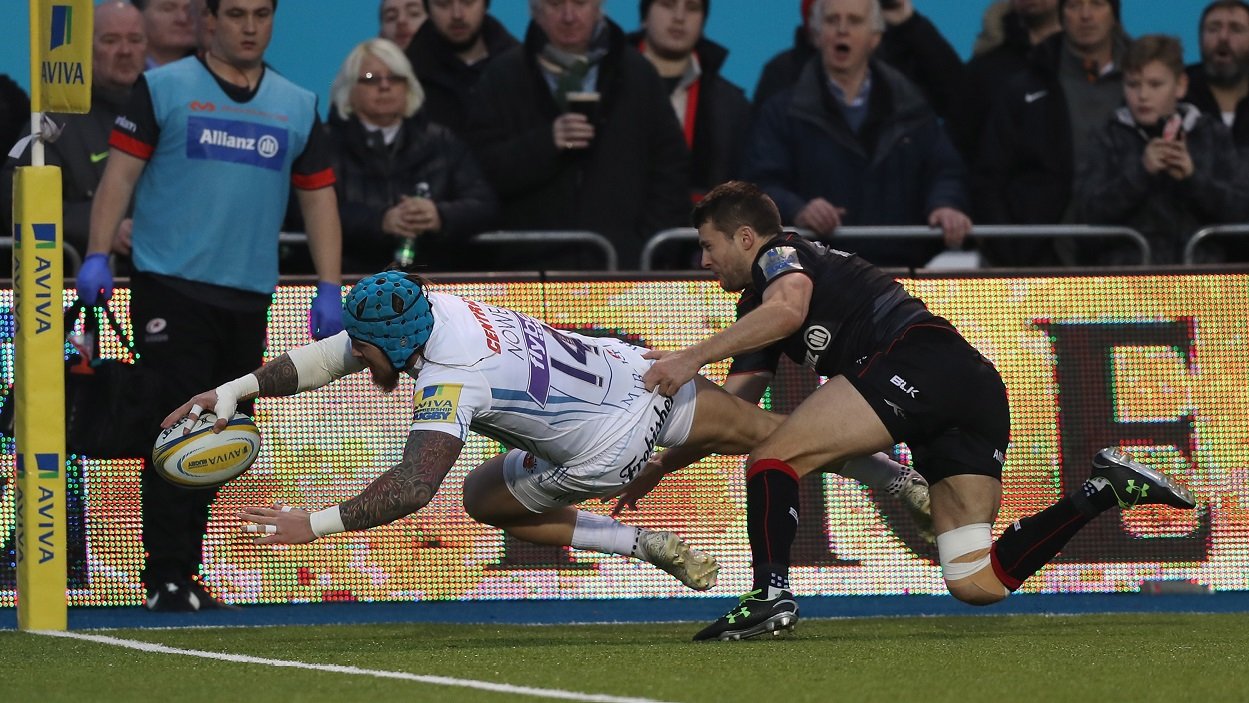The Super Rugbyfication of the Premiership and its fringe defence problem

For many years now, there has been a sizeable group of English rugby fans – and many fans from other northern hemisphere countries – that have looked down their noses at the defensive structures, missed one-on-one tackles and fractured defensive lines of Super Rugby.
Some of the criticism is valid, some is not, but most of all it harks back to a stereotype that the north does defence better than the south and it feverishly defends that stance, even when there is evidence to the contrary.
Equally, that sneering is balanced out by another sizeable group of fans who laud the attacking skill sets and initiative displayed in the southern hemisphere’s premiere club competition. Their eyes are lit up by the cold glow of their bedroom television as they rise at 4am to take in the latest Sunwolves vs Rebels game, adamant that the secret to the north rising to the pinnacle of the game is hidden in a plethora of missed tackles, defensive misreads and structures as wispy and ineffectual as Donald Trump’s so-called-but-you’re-not-really-fooling-anyone barnet.
Again, much of that lauding of skill is welcome and the benefits that countries such as England and Ireland have reaped from a heavy focus in that area in academies and the age-grades have been clear to see.
That said, the placing of a competition on a pedestal is every bit as frustrating as the fans who bemoan the defensive errors in Super Rugby which are, in fact, just a symptom of excellent attacking play.
At the two extreme ends of this spectrum you have fans with very contrasting rugby philosophies.
Plenty believe that many of the Premiership clubs could live – defensively at least – much more competently with the cream of Super Rugby – New Zealand franchises and the Lions – than the majority of sides in the competition currently do, whilst at the other end of the spectrum, fans desperately wish for the Premiership to be as open and end-to-end as Super Rugby.
Well, be careful what you wish for.
Over the last five or so years, the Premiership – and again, much of the rest of the northern hemisphere – has developed a far more open playing style, with players backing their own skill, constantly looking to increase the tempo and playing with more freedom in terms of their position and role on the pitch. Whether you like it or not, the competition has undoubtedly taken on a more Super Rugby-like visage.
This increasing tempo to the game and the new breakdown laws – which plenty of players and clubs are still adapting to – has created a perfect storm of, ahem, “rugby chaos”.
For the uninitiated, that term entered the rugby lexicon this summer during the British and Irish Lions tour of New Zealand, replacing the seemingly much more useful and descriptive term of “clinical and opportunistic attacking play”.
Regardless, the storm is largely centred around the breakdown and tempo plus hesitation at the ruck has equalled fringe defences being picked apart by enterprising scrum-halves and ball-carrying forwards keen to exploit the confusion.
For so long, fringe defence has been a staple of the game that hasn’t really changed.
In an ideal situation, a scrum-half or fly-half would be positioned centrally behind a ruck to prevent a carry through the middle, two pillars (or guards) would be positioned either side of the ruck to protect the fringes and then fanning out either side of them would be posts (or bodyguards).
The posts are there to drop back inside and support the pillars if the attack comes close to the ruck, or fan further out and drift with play if the attacking side puts width on the ball.
It is also often the responsibility of the posts and pillars to make sure that the rest of the defence is organised and in line, i.e. ready to move forward as a unit and smother the attacking play, but not so far forward that they are offside.
This area of the game is increasingly becoming an issue for many Premiership sides.
The protection in the centre of the ruck is often not there – or too deep to prevent a sizable gain – and pillars and posts are too far out from the ruck. They are also often far too upright or stood with hands on their hips, neither of which is putting them in an effective position to affect a tackle if the attacking team carry close to the ruck on the next phase.
Sometimes tempo of attacking play will dictate that defending teams cannot reorganise around the fringes as well as they would like and that has to be dealt with on the fly, but it is leading to bad habits. There have been countless examples this season whereby the defensive side has done a good job of slowing down ball and allowing themselves to get set, only to then see the central protection drift, pillars not take a three-point stance on the fringe and posts not to organise the defence outside of them.
It is showing up in scorelines and statistics, too.
After four rounds of matches, the three players leading the try assists table – Nic White, Chris Cook and Nic Groom – are all scrum-halves, whilst Saracens’ nine Ben Spencer is just one try off the top of the leaderboard, having crossed the whitewash four times already.

Scrum-halves aren’t exploiting cracks in defences around rucks, they’re exploiting chasms
Ben Youngs is one defender beaten away from cracking the top 10 in that category, something usually reserved for outside backs and the odd, elusive loose forward, whilst Richard Wigglesworth, Groom and Spencer all sit among the top 25 players for clean breaks.
It is no longer a case of just Wasps’ high-intensity duo of Dan Robson and Joe Simpson picking defences apart, or internationals Youngs and Danny Care, it is a league-wide phenomenon.
It is worth taking a moment to appreciate the heads-up rugby these players and many others around the league are playing, even if there is damning criticism of the league’s lackadaisical fringe defence to be made.
September rugby does bring with it firmer grounds, new season energy and a desire to play that will all be harder to find as winter descends, but any reduction in attacking endeavour over the coming months shouldn’t detract from what has been poor defensive fundamentals across the competition.
Of course, not every team has performed poorly in this area.
Saracens, as you might expect, have adapted well and maintain their defensive structure and discipline irrespective of the tempo the opposition are attempting to play at. Their pack and back line is loaded with “defensive generals” who are not only very adept defenders, but who also take it upon themselves to make sure everyone around them is in the right position and mismatches are accounted for.
That said, even Saracens’ defence has been affected and their usual aggressive blitz two or three men out from the ruck – designed to force attacking sides back inside – has been tempered somewhat.
If you put the season-opening mauling at the hands of Saracens aside, Northampton Saints have also looked strong. Again, they are another side with no shortage of “defensive generals” and after having seen their defence coach Alan Dickens also assume the mantle of attack coach last season, they are clearly prospering from Dickens focusing solely on attack and former academy coach Mark Hopley being promoted to defence coach this season.

The rise of Courtney Lawes from defensive standout to defensive leader has been one of the stories of the season
Exeter Chiefs have also shown plenty of organisation around the ruck and it is no coincidence that these three teams mentioned currently occupy the top three spots in the league.
The trio of clubs show that with the right conditioning and coaching, you can deal with tempo. It’s the ability to still make the right decisions and perform your duties when you’re out of breath and scrambling into position.
Furthermore, it should encourage clinical breakdown play, with teams less keen to commit numbers to a defensive breakdown – to ensure they can protect the fringes – and putting the onus on individuals to steal, or at least slow, opposition ball.
The much more worrying trend is that of situations when players have the time to organise themselves before the next phase comes, but they are failing to do so. Whether that is due to poor conditioning, a lack of coaching or complacency, is something only the players themselves and their coaches can answer.
The league may be becoming more like Super Rugby in terms of its attacking endeavour and tempo, but the value of an unsexy, unfashionable defensive leader has never been higher. The league is constantly adapting and evolving but some things do remain the same and teams cannot afford to trip themselves up trying to run, before they learn to walk.
If you look at the three dynasties of English rugby in the professional era, where would Wasps have been without Fraser Waters? Would Tigers have had the same success they did without a figure like Martin Corry? Has there been a more influential player at Saracens than Brad Barritt?
Currently, there are several clubs in the Premiership who don’t have figures like these in their squads and you can see it clearly in a facet of the game like fringe defence.
It doesn’t require an incredible level of skill or even an ability to read the game, it is an entirely coachable and learnable aspect of the sport, that simply requires good conditioning and good discipline, and it is something that is currently being exploited by attacking sides.
Maybe this will cause Super Rugby detractors to revaluate their opinion of defences in that competition and maybe those who solely laud the attacking skill of sides will look to Saracens, Exeter and Northampton and appreciate the defensive skills that also permeate the best sides. Three sides, it must be said, that also lead the league in tries scored.
Regardless, the fans at both ends of that spectrum have got their wishes – to some degree – and it will be interesting to see how the season continues to unfold as teams get more comfortable with the new breakdown laws.
Even if the winter months do bring some respite for defences, it could just be the eye of the storm before the firmer grounds come again in the season’s final third.
























